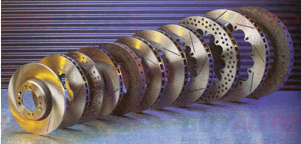The brake disc is the component against which the brake pads clamp on to slow or stop the wheels. The friction between the disc and pads causes the requisite braking action in the wheels. Other components involved in braking include the master cylinder and caliper. The disc is a circular component with a machined surface on both of its sides. The brake disc is held in place by two set screws and a center nut. In some automobiles, the disc is simply attached to the wheel. The disc is usually made of cast iron or ceramic.

In addition to the standard “smooth” type of brake rotor, there are more specialized brake discs that can improve brake performance under heavy braking by better handling the large amount of heat, dust, and gasses generated due to friction between the pad and the rotor surface.
The first specialized type of brake rotor is the slotted rotor. As its name implies, the slotted rotor has channels or “slots” machined into its friction surface which allows the gas and brake dust generated by brake pad wear during braking to escape the braking surface, creating better contact between the pad and rotor and more friction. These slots also help the face of the rotor cool more evenly, reducing the likelihood of brake rotor warpage from overheating.
Similarly, cross-drilled brake rotors have holes in their face that directly link the friction surface of the rotor to the internal cooling vanes. These cooling holes not only look great behind the wheels of your vehicle, they also help to lower brake temperatures and provide a path for both brake dust and pad outgassing, again improving contact between the pad and brake rotor. In addition, when the car drives in rainy conditions, the holes in the rotor can quickly drain the water improving initial brake bite.
Some rotors even combine cross-drilled and slotted brake rotor designs to offer the best of both worlds: great initial bite in wet and dry conditions, superior cooling capacity, decreased brake fade, and fantastic looks.
Disc brake systems are superior to drum brake systems in various ways. The disc brakes require no adjustments to the rotor when they are installed. A further benefit of disc brakes is that heat gets easily dissipated compared to drum brakes.

Problems in a Brake Disc
- Generally, the brake calipers are the ones that wear out quicker than brake discs. However, the brake rotor, in the long run, can become thin and fail to dissipate the heat. This results in a poor braking performance.
- Sometimes, the brake disc may develop warps, failing to provide an efficient braking.
- The brake pads can lose their friction material over time, resulting in a metal-to-metal contact between the pad and rotor. This will also cause the brake disc to go bad.
- The brake disc in vehicles which have not been driven for a long time can develop rust. This can be rectified by machining the rotor.
- A warped brake disc rotor can also affect the anti-lock braking system.
- The brake disc can fail due to brake-fluid leaks. This can cause the fluid to coat the surface of the rotor.
Symptoms of a Bad Brake Disc
- A grinding or squealing noise while braking is often a symptom of bad brake discs. However, the grinding noise may also be emitted when the brake pedal is not pressed and can get louder while braking. This also indicates a bad disc rotor.
- A defective brake disc can cause the vehicle to vibrate or lurch when the brake pedal is pressed. This condition is often called a "shimmy".
- A bad brake disc an also cause your steering wheel to vibrate even at normal speeds.
- Pulsating brakes are also a common indication of damaged brake rotors.
- A disc rotor that has completely gone bad can cause your vehicle to stop roughly. On the contrary, a worn-out rotor can also increase the stopping distance of your vehicle.
- Other problems due to a bad brake disc include loss of wheel torque and diminished steering response.
- If a failed brake rotor is not attended at the earliest, it can wreak havoc in the entire braking system and performance.
Maintenance
As with all auto parts, the brake discs also need to be inspected regularly. Cleaning the rotors with a brake cleaning fluid spray is also critical to keep foreign particles and brake dust out, and prolong the lifetime of the rotor.


